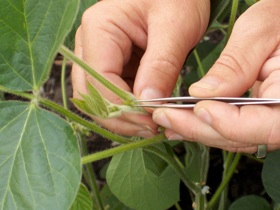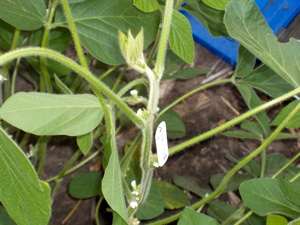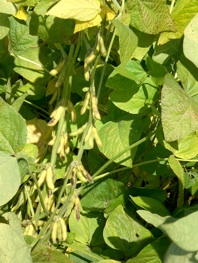Genetic Recombination of Parental Germplasm
 Hybrid soybean seed produced from the cross of two parents can be referred to as F1 seed. The F1 seed gets half of its genetic makeup from each parent. If the two parents are pure-line varieties, as is often the case in soybean, then all the F1 seed produced from the cross is heterozygous. That is, the F1 seed possesses one allele of each gene from each parent.
Hybrid soybean seed produced from the cross of two parents can be referred to as F1 seed. The F1 seed gets half of its genetic makeup from each parent. If the two parents are pure-line varieties, as is often the case in soybean, then all the F1 seed produced from the cross is heterozygous. That is, the F1 seed possesses one allele of each gene from each parent.
To illustrate the point, let’s refer to four different genes in the soybean plant with the letters A, B, C, and D, or a, b, c, and d. The capital letters indicate an allele for a gene that is dominant, while small letters indicates a recessive allele for the same gene. Soybean has two copies of each gene, one from each parent. This is referred to as a diploid plant. Let’s say that parent 1 at these four genes possesses the genetic makeup AAbbCCdd, while parent 2 possesses the genetic makeup aaBBccdd.The F1 seed will get one allele of each gene from each parent. So the genetic makeup of all the F1 seed from the cross of parent 1 x parent 2 is AaBbCcdd. The F1 seed in this example is heterozygous (has two different alleles) for the first three genes because the two parents have different alleles for those genes. The fourth gene is homozygous (the alleles from the two parents are identical).
Since soybean is a naturally self-pollinated plant, we can allow the F1 plant to self-pollinate. In other words, the F1 plant becomes both the female parent and the male parent of the next generation of seed, referred to as F2. This is where the process gets fun. To illustrate, it can be written as AaBbCcdd x AaBbCcdd. The F1 plant contains two different alleles for the first three genes. Only one or the other of those two alleles can be passed on to each individual F2 seed from the female and from the male. But since the F1 plant can produce many seeds, there are many opportunities for either the dominant or recessive alleles to be passed on to different seeds. For this example, there are 27 different possible genetic combinations that can occur in the F2 seed from this example. The different genotypes and their expected frequencies are listed below:

1/64AABBCC
1/32AABBCc
1/64AABBcc
1/32AABbCC
1/16AABbCc
1/32AABbcc
1/64AAbbCC
1/32AAbbCc
1/64AAbbcc
1/32AaBBCC
1/16AaBBCc
1/32AaBBcc
1/16AaBbCC
1/8AaBbCc
1/16AaBbcc
1/32AabbCC
1/16AabbCc
1/32Aabbcc
1/64aaBBCC
1/32aaBBCc
1/64aaBBcc
1/32aaBbCC
1/16aaBbCc
1/32aaBbcc
1/64aabbCC
1/32aabbCc
1/64aabbcc
I have ignored the fourth gene (dd) in this list since all the plants would be the same.
 One can see from the above list that, even with this simple example of three independently segregating genes, genetic recombination via self-pollination of an F1 plant can produce a wide assortment of genotypes. Now consider that a soybean genome possesses thousands of genes that influence all the different characteristics of the plant. The list of possible genotypes can become extremely large very quickly. The probability that any two F2 plants are genetically identical for all genes is extremely low. Therefore, from a practical point of view, the F2 population can be grown and each F2 plant in the population can be considered to be genetically different from every other plant. Selection among plants can take place in the F2 generation or subsequent generations.
One can see from the above list that, even with this simple example of three independently segregating genes, genetic recombination via self-pollination of an F1 plant can produce a wide assortment of genotypes. Now consider that a soybean genome possesses thousands of genes that influence all the different characteristics of the plant. The list of possible genotypes can become extremely large very quickly. The probability that any two F2 plants are genetically identical for all genes is extremely low. Therefore, from a practical point of view, the F2 population can be grown and each F2 plant in the population can be considered to be genetically different from every other plant. Selection among plants can take place in the F2 generation or subsequent generations.
In order to speed up the process of variety development, it is possible to grow soybean in a tropical environment during the winter. By doing so, two or more generations can be completed in one year. Galena Genetics often utilizes winter nursery facilities in Puerto Rico to grow the F1 generation during the early winter followed by the F2 generation during late winter. So around the last week of January each year, I must travel to Puerto Rico for a week to oversee harvest and threshing of F1 plants, and planting of F2 seed. However, since the environment of Puerto Rico (or any other tropical environment) is extremely different from the environment in the Midwest USA, selection within the F2 populations grown there is of little value. Therefore three seeds from each plant in the F2 population are harvested and bulked to form an F3 bulk population which I plant in the Galena Genetics research nursery back in Minnesota the following spring. Selection among F3 plants for characteristics like maturity, seed quality, and disease and insect resistance can be done at this time. Selection for complex characteristics like yield is not usually done on individual plants.
In the fall, F3 plants are harvested and threshed individually to obtain F4 seed. Since each F3 plant is threshed separately, the F4 seed from that plant creates a line of plants that are all closely related to each other and are partially homozygous. F4 lines that are derived from individual F3 plants are referred to as F3:4 lines. The 3 represents the generation of the individual plant from which the line is derived. The 4 represents the current generation of the seed or the plants in the field.
